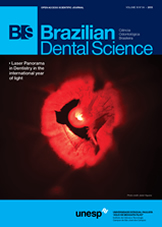Diagnostic reliability of a simplified epidemiologic tool to detect high-risk overjet for dental trauma.
DOI:
https://doi.org/10.14295/bds.2015.v18i4.1167Resumo
Objective: To evaluate the diagnostic reliability of a simplified tool to detect high-risk overjet for dental trauma. Material and Methods: The study population was composed of 131 volunteers divided into two groups according to the overjet measurement in terms of risk for traumatic dental injury (GRAB: risk absent and GRPR: risk present). The distance between the most prominent labial surface and its corresponding counterpart was measured using both the conventional (WHO, 1997) and the simplified tool. The measurements were taken independently and on separate occasions by two previously calibrated dental surgeons (Kappa=0.86). The gold standard method, as recommended by the WHO (1997), was performed by an external examiner. The simplified method, based on pencil-marked wooden tongue depressors was carried out in a blind manner by the other examiner. Sensitivity, specificity, positive and negative predictive values were calculated for the classification of risk for dental trauma in terms of overjet using the simplified method and compared to the conventional method. Results: The results revealed high values for sensitivity (S=1), specificity (E=0.93), positive (PPV=0.95) and negative predictive value (NPV=1). Conclusion: The examination using the simplified tool was reliable in identifying high-risk overjet, thus offering an alternative to the conventional examination.Downloads
Downloads
Publicado
Como Citar
Edição
Seção
Licença
TRANSFERÊNCIA DE DIREITOS AUTORAIS E DECLARAÇÃO DE RESPONSABILIDADE
Toda a propriedade de direitos autorais do artigo "____________________________________________________________________" é transferido do autor(es) para a CIÊNCIA ODONTOLÓGICA BRASILEIRA, no caso do trabalho ser publicado. O artigo não foi publicado em outro lugar e não foi submetido simultaneamente para publicação em outra revista.
Vimos por meio deste, atestar que trabalho é original e não apresenta dados manipulados, fraude ou plágio. Fizemos contribuição científica significativa para o estudo e estamos cientes dos dados apresentados e de acordo com a versão final do artigo. Assumimos total responsabilidade pelos aspectos éticos do estudo.
Este texto deve ser impresso e assinado por todos os autores. A versão digitalizada deverá ser apresentada como arquivo suplementar durante o processo de submissão.




























